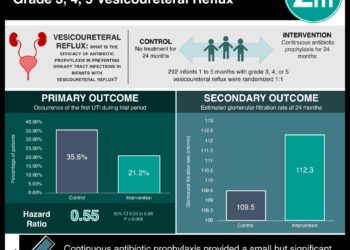Combination antibiotics before C-section may reduce risk of endometritis
1. Women receiving cefazolin and azithromycin before cesarean section skin incision were less likely to develop endometritis than those receiving only cefazolin after cord clamping.
2. Cefazolin dosing by BMI did not impact the incidence of endometritis.
Evidence Rating Level: 2 (Good)
Study Rundown: Endometritis, or infection of the decidua, is a common cause of postpartum morbidity. Postpartum endometritis typically has a polymicrobial etiology involving aerobes and anaerobes from the genital tract. Risk factors include cesarean delivery, chorioamnionitis, prolonged labor, prolonged rupture of membranes, and vaginal colonization with group B strep or E. coli. Given the elevated risk of endometritis following cesarean delivery, antibiotic prophylaxis has been demonstrated to greatly reduce the incidence of endometritis. Current guidelines support administration of a single narrow spectrum agent prior to skin incision, but some studies suggest that combination therapy further reduce risk. In the present work, authors compared the incidence of endometritis in women receiving cefazolin 1g after cord clamping, combination cefazolin 1g and azithromycin 500mg before skin incision, and BMI-dosed cefazolin and azithromycin 500mg before skin incision. They found that rates of endometritis were lower in both groups receiving combination therapy.
Strengths of the study were large sample size and adaptation of antibiotic regimens according to the most current evidence-based guidelines. The study was limited by retrospective design and potentially confounded by the comparison of groups in different time periods such that women in the cefazolin-only group underwent surgery between 2003-2007, when other factors that may impact cesarean-related infectious morbidity, like the widespread institution of the surgical checklist, may not have been in use. Timing of antibiotic prophylaxis administration with respect to skin incision might also confound results. Further evaluation of antibiotic prophylaxis for reduction of cesarean-related infectious morbidity are merited to identify the most clinically and cost-effective options.
Click to read the study in AJOG
Relevant Reading: Decreasing incidence of post-cesarean endometritis with extended-spectrum antibiotic prophylaxis
In-Depth [retrospective cohort]: This study compared rates of endometritis among women undergoing cesarean section from 2003-2007 who received cefazolin 1gram (g) after cord clamping (n = 1034), from November 2008-December 2013 who received cefazolin 1g and azithromycin 500mg prior to skin incision (n = 4484), and January-December 2014 who received azithromycin 500mg and either cefazolin 2g if BMI<30 or 3g if BMI>30 (n = 937) before skin incision. The primary outcome of interest was endometritis, which was a clinical diagnosis made in the presence of temperature >37.5 degrees Celsius, tachycardia, and uterine pain or tenderness.
Among women undergoing cesarean section, 16% of those who received 1g cefazolin after cord clamping developed endometritis, compared to 1.3% of those who received azithromycin 500mg and cefazolin 1g before skin incision (p < 0.0001) and 2.3% of those who received the BMI-dosed cefazolin and azithromycin combination before skin incision (p < 0.0001). Among women undergoing cesarean who received combination antibiotic prophylaxis prior to skin incision, BMI-adjusted dosing of cefazolin was not associated with significantly different incidence of endometritis (1.3% vs 2.3%, p > 0.05).
Image: PD
©2015 2 Minute Medicine, Inc. All rights reserved. No works may be reproduced without expressed written consent from 2 Minute Medicine, Inc. Inquire about licensing here. No article should be construed as medical advice and is not intended as such by the authors or by 2 Minute Medicine, Inc.




![Adverse pregnancy outcomes associated with thrombophilias [Classics Series]](https://www.2minutemedicine.com/wp-content/uploads/2015/07/Classics-2-Minute-Medicine-e1436017941513-350x250.png)
![Small-molecule inhibitor may enhance recovery after brain hemorrhage [PreClinical]](https://www.2minutemedicine.com/wp-content/uploads/2016/03/800px-Intracerebral_heamorrage-75x75.jpg)



